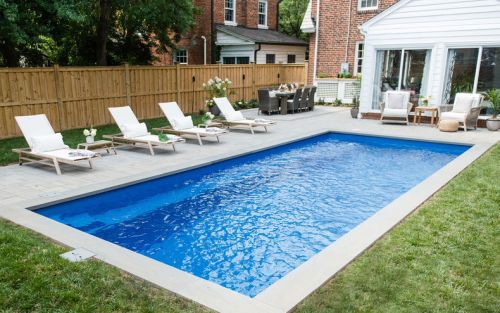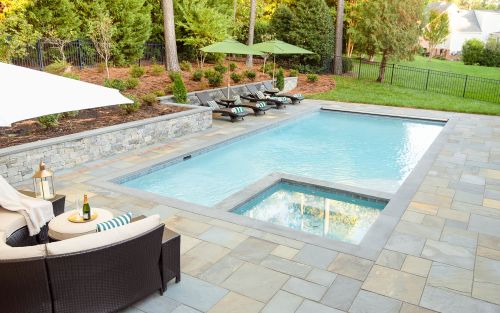Planning
10 Tips for Keeping Your Pool Project on Budget

Story Highlights
Gunite and Fiberglass swimming pools are the most expensive feature you can include in your outdoor living space. Because of this, outdoor renovation projects that include a pool have escalating costs and a tendency to go over budget.
If you're like most homeowners, staying on budget is essential. In this guide, we provide 10 tips for keeping your pool project on budget. Whether you are in the planning phase or design process, these tips are sure to help keep your pool project costs under control!
Tip #1
Set a Realistic Budget
It's much easier to stay on budget if you set a realistic one from the outset.

What you should expect to spend
Complete Pool Projects typically start between $175,000 - $225,000 and include:
A Gunite or Fiberglass Pool Shell
Pool equipment with salt chlorinator and heater
Automatic Cover or Fence
Electrical and Gas Utilities
Pool Coping and Decking
Landscaping, Irrigation, and Outdoor Lighting
All necessary Site Work (demolition, excavation, trenching, grading, soil removal, and drainage).
Pool projects that include additional outdoor living features and patio space usually require an investment ranging from $250,000 to over $400,000.

Over and Under Investment
Though you can certainly spend more or less than the discussed ranges, over and under-investing in a pool project present risks.
Spending too much on your pool may not provide a great return on investment if you sell the home in 3-5 years.
Conversely, spending too little can actually devalue your home if future buyers see the poolscape as inadequate and something they must redo. Your home can also be devalued if the poolscape is falling apart because you failed to invest in quality construction.

tip #2
Consider Phases
If you're looking to build a poolscape with multiple features, consider approaching your project in phases. Be sure to make this decision early in the process and share the initial budget with your designer. When approached thoughtfully, a good designer can put together an optimal phased plan that limits demo and rework, saving you money.
Features like grill islands, outdoor kitchens, and fireplaces can easily be added at a later date if designed on the edge of a patio.

Tip #3
Size Matters
When designing your pool, it's important to remember that size matters. Increasing or decreasing the size of your pool can affect almost every cost of the project, including:
The Excavation Cost
The Soil Hauling or Re-grading Cost
The Pool Tile Cost
The Pool Coping Cost
The Pool Equipment Cost
The Water Fill & Chemical Cost
The Pool Decking Cost
The Automatic Cover (or Fence) Cost
The Landscaping & Lighting Cost
The Retaining Wall Cost (if necessary)
If you're looking to keep your pool project on budget, consider a smaller pool. Shaving a couple of feet here and there likely won't affect the pool's use and has the potential to save you thousands of dollars over the entire project.

tip #4
Work with your property...
Challenging site conditions, like slopes, poor soils, and existing trees, can add significant costs to your pool project. With every property, there is an optimal way to work within the site's conditions and, sometimes, use them to your advantage. If you're trying to stay on budget, it's essential that you work with your property so that you can avoid or limit the unwanted costs of overcoming site conditions.

tip #5
Gunite vs. Fiberglass
Though a simplistic gunite pool can be similar in price to fiberglass models, gunite becomes more expensive when homeowners decide to customize their pools with features like tanning ledges, benches, expansive stairs, unique bottoms, and finish upgrades.
With fiberglass pools, these features are part of the prefabricated designs and do not significantly increase the price. Additionally, fiberglass pools have dimension limitations (because of shipping) that help to control project costs by limiting the size of your pool (see Tip #3).

tip #6
Design for your Furniture Needs
Too often furniture is an afterthought when designing outdoor spaces. This frequently leads to designers creating large, open poolscapes with a lot of extra decking. Though open space does offer versatility, it is often a waste of money. For this reason, we recommend that you think through your furniture needs early in the process and design to meet those needs specifically.
If you only want 4 chaise lounge chairs, don't pay for a space that's big enough to hold 8. The same logic should be applied to traditional lounge areas, bar-tops, dining tables, etc.

tip #7
Minimize Decking
Do you need 10-foot wide decking all the way around the pool? Or is 4 feet enough in some areas?
Is decking on all sides of your pool necessary?
Minimal pool decking is a growing trend among homeowners for its sleek and elegant look as well as its cost savings. Optimizing and/or minimizing your decking can save you thousands of dollars on your pool project.

Tip #8
Fence vs. Auto-Cover
To meet the building code in Virginia, your pool must be enclosed by a fence or an automatic cover. If you're trying to keep your project on budget, it's worth pricing both to see which is more cost-effective. Though automatic covers are an expensive feature, they often cost less than enclosing an entire backyard with aluminum, premium wood, and PVC fences.
Also, remember that the automatic cover will act as your pool's winter cover as well. When comparing the costs of an auto-cover and fence, be sure to factor in the winter cover as part of your fence pricing.

Tip #9
Avoid Curved Pools
Many homeowners want curves in their outdoor spaces. Understandably, curved, free-flowing spaces feel more natural and better embrace the outdoor environment. That said, if you're trying to stay on budget, curved pools should be avoided.
Curved pools and hardscapes are created through skilled craftsmanship. The process of creating curves requires more labor and materials, increasing the cost of your pool project. Curves will increase the cost of your pool's excavation, structure (if gunite), coping, decking, and retaining walls (if needed). Depending on the design, curves can add anywhere from 10-25+% to the costs of your pool project.

Tip #10
Minimize (but don't eliminate) the Landscape & Lighting
When homeowners need to cut costs from their outdoor projects, the most common place to start is landscaping and lighting. That said, after a year of living in the space, the most common regret of these homeowners is having cut back on landscaping and lighting.
Dollar for dollar, we believe that nothing will add more value to your poolscape than landscaping and lighting. Landscaping will increase the tranquility of your poolscape and put you in touch with nature. Low voltage lighting will provide a stunning ambiance and allow you to enjoy your pool better after the sun goes down.

Bonus tip #11
Work with a Thoughtful Designer
As this post demonstrates, staying on budget is difficult and requires extensive thought. If you plan to work with a professional designer, be sure to hire an individual that you are confident will thoroughly think through your project and value-engineer the space to keep you on budget.
At Outdoor Dreams, we offer a unique process that was developed specifically to keep clients on budget and produce a design that is ready to build.
Estimating Third-Party Designs
Estimating Third-Party Designs
At Outdoor Dreams, we occasionally receive inquiries from homeowners or designers asking if we can provide an estimate based on plans that have already been developed by another architect, landscape architect, or designer. While the answer is yes, it’s important to understand that our approach is different from a traditional contractor's—and it comes with a $1,500 fee. Here's why...
Budgeting for Your Swimming Pool Project: A Detailed Breakdown
Budgeting for Your Swimming Pool Project: A Detailed Breakdown
In this guide, we’ll break down the various elements that contribute to the total cost of a pool project—from structural engineering to landscaping—so you can see how each part contributes to creating a stunning, long-lasting pool environment.